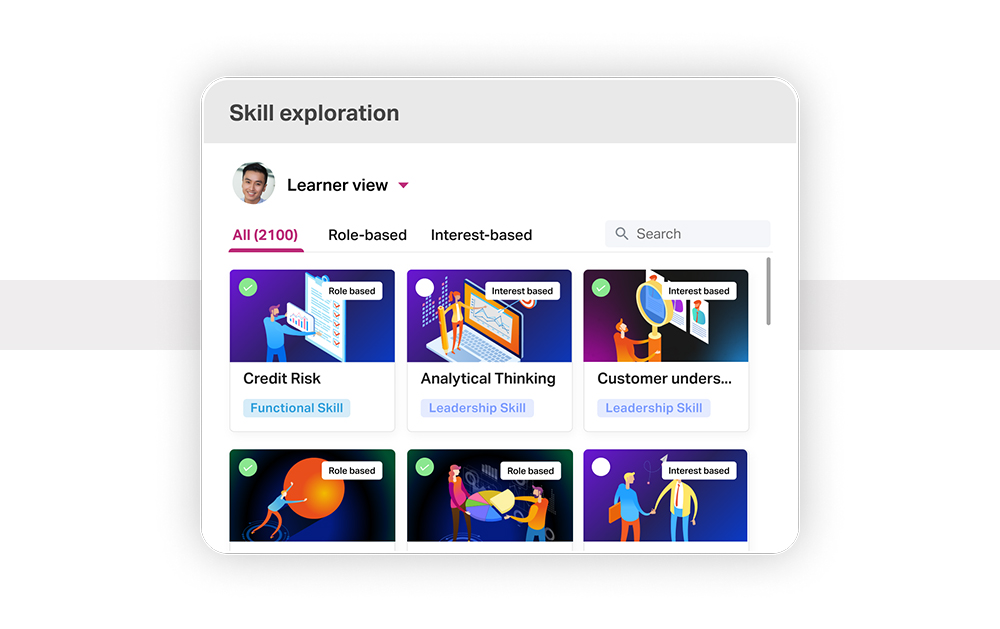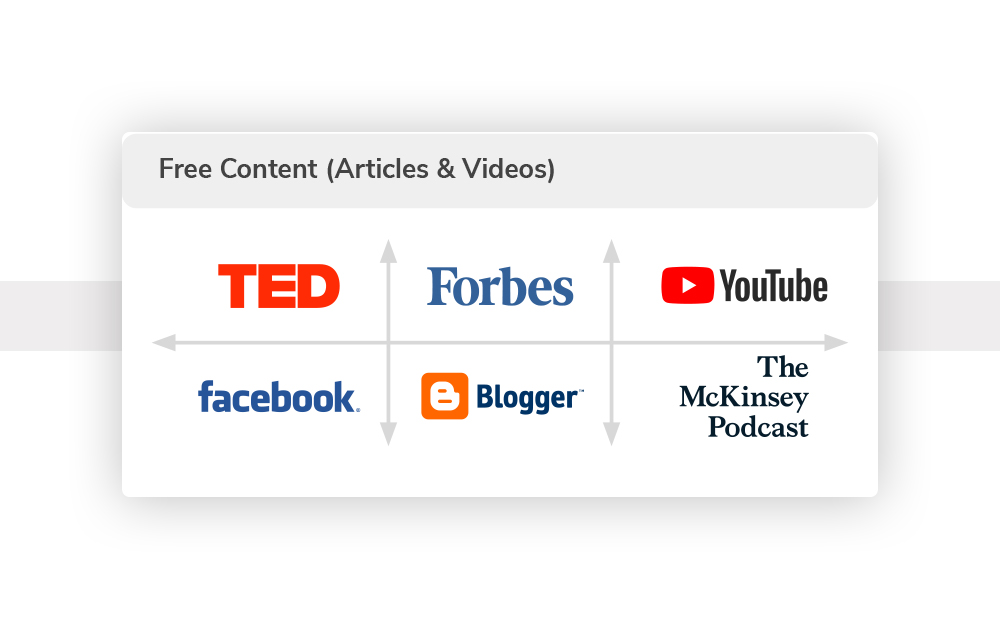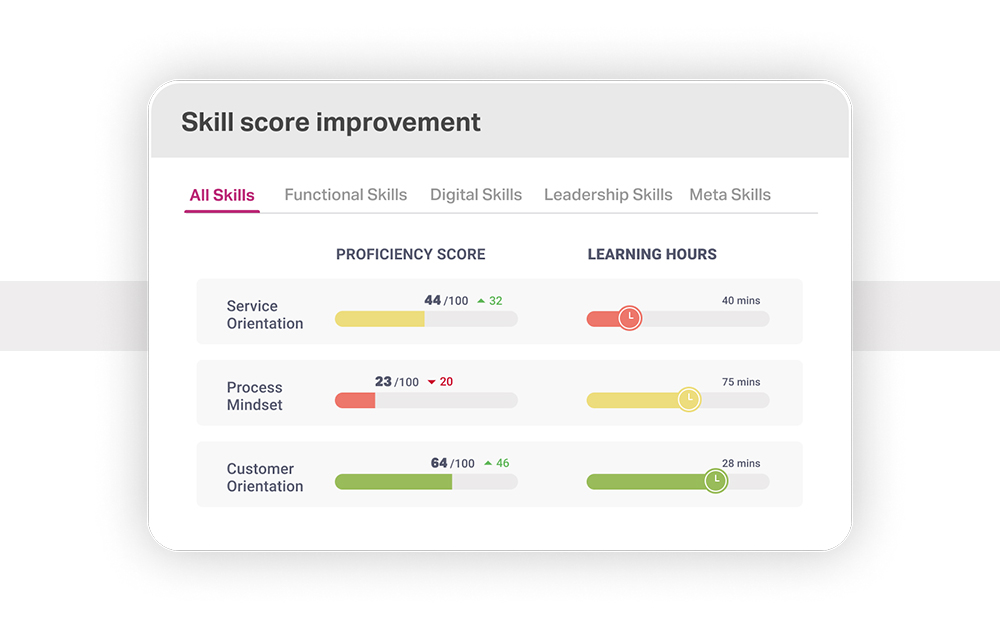As per a LinkedIn report on Workplace Learning, 92% of executives shared that there is a skill gap in the workforce. In addition, 90% of them also stated that learning and development programs help bridge this gap.
In today’s rapidly changing business landscape, companies must implement effective employee skill development strategies for consistent growth. That’s where LXP solutions come in, providing a modern and engaging learning experience for employees to learn and grow.
LXP solutions provide an engaging and personalized learning experience for employees, enabling learners to acquire new skills and knowledge that they can apply to their jobs. However, the abundance of available learning system options can be overwhelming when determining the essential features to look at for your organization when selecting an LXP.
12 Essential Features for the Ultimate LXP Experience
When selecting a learning platform for employee skill development, it is imperative to choose an LXP solution that can effectively support your skilling initiatives. In addition, it should also have the capability to enhance your existing learning management system (LMS).
Check whether the below list of LXP features is present
1) AI-powered Learning & Personalized Recommendations
AI, adaptive learning, and machine learning are transforming LXP solutions, with vendors constantly innovating to keep them at the forefront. One standout feature is AI-driven content recommendations, which save time and costs by tailoring learning paths to individual needs. These systems use advanced algorithms to identify skill gaps and provide personalized training, accelerating development. When assessing an LXP, ensure it delivers real-time updates and recommendations aligned with peer learning trends to stay competitive.
2) Advanced Skills Gap Analytics
To assess the effectiveness of your training programs especially in key stakeholder meetings advanced skills gap analytics are essential. Your LXP should provide robust data analytics and reporting tools to evaluate whether upskilling and reskilling initiatives are closing skill gaps and meeting business goals. Ensure that the platform supports xAPI and SCORM for smooth integration with your existing systems. Given the unique learning needs of each organization, check that the LXP includes customizable assessment dashboards for courses, classrooms, groups, and managers. Additionally, the platform should offer comprehensive tracking, filtering, and reporting on the skills your employees are acquiring to provide actionable insights.
3) Gamification for Engagement
Gamified learning has proven to enhance employee engagement, driving a 48% increase in participation when integrated into work experiences. Key gamification elements like achievement badges for mastering skills, leaderboards encouraging friendly competition, and interactive quizzes help create a collaborative and dynamic learning environment. These features make learning more engaging, motivating employees to participate and achieve more.
4) Content Aggregation & Curation from External Sources
Your learning experience platform should empower, not restrict, your ability to create and curate eLearning content. A modern LXP lets you source materials from across the web, helping you craft personalized upskilling and reskilling programs. Ensure the platform integrates seamlessly with your existing LMS and third-party tools like LinkedIn or Salesforce. To streamline onboarding and content creation, look for solutions that offer AI-powered tools for quick and efficient content generation.
5) Mobile Learning with Offline Capabilities
A modern LXP should enable seamless mobile learning, allowing users to access training anytime, anywhere. An intuitive mobile app is key to an effective learning experience. It should support features like microlearning, adaptive design, offline access, and interactive tools such as quizzes to enhance engagement and boost retention.
6) Skills Inventory
A skills inventory is a valuable tool for any organization that aims to enhance employee learning and development (L&D). This feature serves as a centralized repository that contains all the necessary skills and their corresponding proficiency levels for each role.
This essential feature is particularly useful, as it offers a comprehensive solution to map out the required skills and understand the demands of each role. By leveraging its capabilities, L&D leaders can enhance employee performance, drive engagement, and stay ahead of the competition in today’s fast-paced and competitive corporate world.

7) Deep Skill Proficiency Assessments
The deep skill proficiency assessment assists L&D professionals in precisely evaluating each employee’s skill level. This is achieved through the use of data-driven metrics that provide an accurate and comprehensive view of employee performance. Leveraging LXP solutions that deliver these metrics ensures that you have a clear understanding of each employee’s strengths and areas for improvement.
With this expertise, L&D professionals can customize training programs that enhance employee performance. By analyzing the current skills of the workforce, the (L&D) team can create tailored skilling initiatives and a personalized learning path that address any gaps in expertise, resulting in the organization’s advancement and success.

8) Role-based Personalized Learning Journeys
According to research, personalized learning is considered essential to maintaining employee engagement by 77% of L&D professionals. Role-based hyper-personalized journeys offer each employee a tailored learning experience based on their role within the organization. L&D leaders can use this to design learning paths for employee training explicitly geared to help them succeed in their jobs.
Consider a tech company’s learning and development team utilizing this feature to curate tailored learning paths for their diverse workforce. With the ability to create specialized training, programs such as a software engineering learning track can incorporate…
-
Technical training
-
Practical projects
-
Mentorship opportunities
-
Targeted instruction
Having the ability to have a personalized learning path enables your L&D team to optimize the learning and growth potential of each employee.
9) Easy Content Creation and Integration
Say adios to the hassle of searching for quality training content with access to a massive library of 10 million+ learning assets. When selecting an LXP solution, it is important to consider that it provides your organization access to a vast pool of resources for skills development, including training programs, learning courses, books, articles, videos, online forums or communities, and simulations.
LXP solutions also broaden the horizon by offering content integration with free and paid digital courses, allowing learners access to an extensive range of learning materials and learning approaches that work best for them.
You can seamlessly integrate LXP solutions with various content sources, such as Forbes, YouTube, The McKinsey Post, Udemy, eCornell, Go1, edX, and Coursera. This not only enhances your learning experience but also fosters an effective approach to skill development. It ultimately results in improved performance and productivity, benefiting both the learner and the organization.

10) Strategic Talent Segmentation: Leveraging performance & potential for optimal resource allocation
In today’s dynamic work landscape, having a strong talent development strategy is essential for organizational success. Thus to effectively manage and develop talent, L&D teams require a framework that assesses potential and performance to manage and develop talent effectively. That’s where LXP’s Talent Segmentation feature can prove to be a game changer.
By utilizing a performance vs potential matrix that incorporates KPI scores and role scores, LXP offers real-time insights into employee performance and potential. This allows you to visually compare and prioritize initiatives that drive change in leadership and employee experience, ensuring maximum returns on human capital investments.
11) Skill-driven career progression
Did you know there is a 34% higher retention rate where organizations lay out the proper career progression path? The current job market is fast-paced and competitive, causing employees to desire more control over their career paths. To retain outstanding employees, L&D professionals must offer career advancement opportunities and possibilities to upskill. This is easily done with the right LXP solution in play.
Achieving this through an LXP’s skills-based career progression empowers employees to take control of their career development. The right LXP solution provides customized roadmaps for both horizontal and vertical advancement. This approach enables employees to prepare for potential roles and obtain the skills necessary to advance their careers within the company.

12) Maximizing Talent Management with Data-Driven Skill and Role Scores
Assessing the effectiveness of learning and development initiatives be it on-the-job learning, training programs, workshops, or courses is essential. LXP’s skill and role score analytics offer L&D decision-makers instant visibility into employee advancement, involvement, and upskilling in real time.
Keeping track of staff proficiency enhancements is critical for maintaining a competitive edge. By embracing continuous learning and development, organizations can empower themselves to boost employee adoption and drive growth.

How can the right LXP Solution help your business?
By leveraging the comprehensive features of LXP solutions, modern organizations can transform their learning and development programs, enhance talent management, and stay ahead of the competition. With capabilities ranging from skill dictionaries to skills-based career progression, the right LXP is a powerful tool that can take your business to the next level. Here are the key takeaways from the features mentioned:
-
Skills dictionary for identifying areas for development.
-
Deep skill proficiency level assessment to measure proficiency level and identify areas for development.
-
Role-based hyper-personalized journeys for targeted skill development.
-
Content integrations for diverse knowledge resources.
-
Talent segmentation based on performance & potential for targeted development initiatives.
-
Career progression based on skills to navigate employee careers based on skills and competencies.
-
Skill and role score analytics for continuous improvement and refinement of skills development programs.
These attributes help L&D leaders raise the bar of L&D efforts with its advanced analytics, personalized journeys, and integrations. Whether you’re looking to assess employee skill proficiency, drive engagement, or help employees advance their careers, Disprz LXP has you covered.
Disprz LXP solutions offer a comprehensive platform with deep skill assessments, a skills dictionary, and personalized learning journeys, empowering your employees to acquire the skills they need to succeed.
Get ready to unleash employee potential and see the organization soar to new heights.








